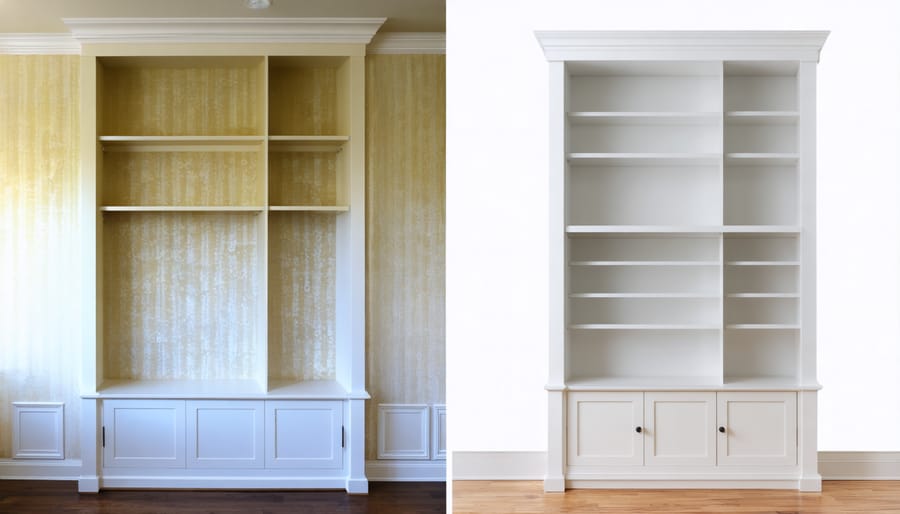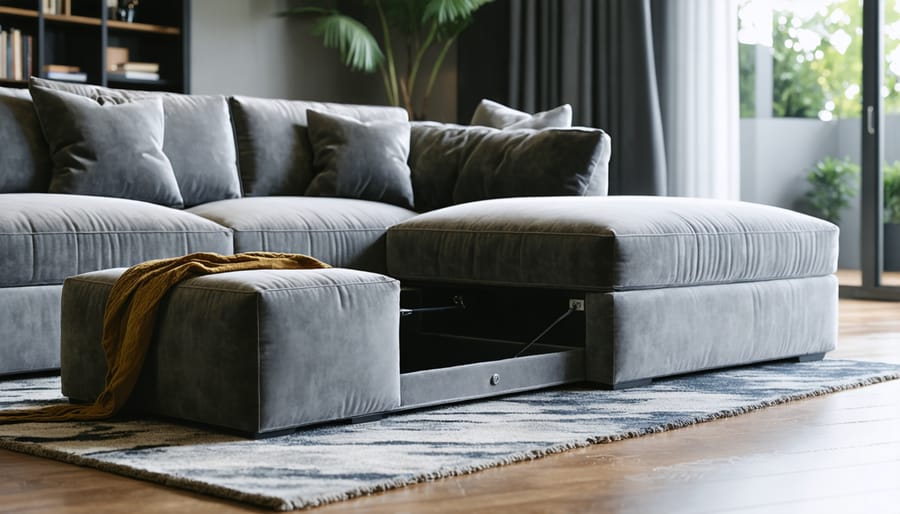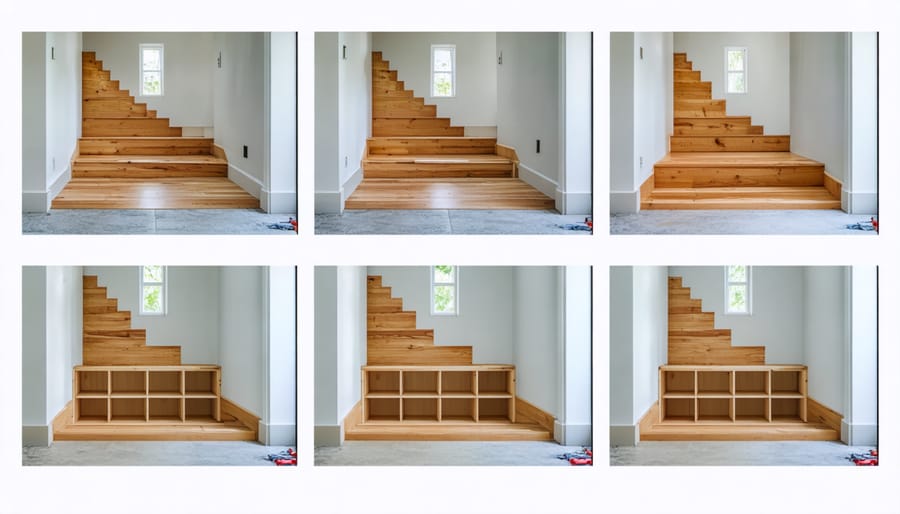Transform your living space into a masterpiece of organization with strategically placed hidden storage spaces that blend seamlessly into your home’s design. Camouflage storage revolutionizes how we think about organizing our homes, combining functionality with aesthetic appeal to create spaces that work smarter, not harder.
Whether you’re dealing with a cozy apartment or a spacious house, clever camouflage techniques can transform cluttered areas into sophisticated, organized environments that maintain their visual appeal. From built-in solutions that disappear into walls to furniture pieces that double as storage units, the art of concealment offers endless possibilities for homeowners who value both form and function.
Modern camouflage storage solutions have evolved beyond simple hidden compartments, now incorporating innovative design elements that complement your home’s style while maximizing every square inch of available space. By understanding the principles of camouflaged storage, you can create a living environment that’s both beautifully organized and perfectly tailored to your lifestyle needs.
The Art of Blending: Core Principles of Camouflaged Storage
Color Matching and Material Selection
Successful camouflage storage starts with understanding basic color matching principles and selecting appropriate materials. When choosing colors, take cues from your existing décor – look at your walls, furniture, and dominant accent pieces. For seamless integration, pick shades that are either exact matches or slightly darker than your current color scheme.
Consider the texture and finish of materials as well. If your room features matte surfaces, opt for similar non-reflective materials for your storage solutions. For modern spaces with glossy elements, high-shine finishes can help your storage blend naturally. Popular material choices include painted MDF for budget-friendly options, natural wood for traditional spaces, and sleek laminates for contemporary settings.
Don’t forget about patterns and prints – they can be excellent camouflage tools when used strategically. If you have wallpaper, consider using the same pattern on your storage surfaces. For solid-colored walls, textured materials in matching shades can add subtle depth while maintaining the camouflage effect.
Test your chosen materials and colors in different lighting conditions before committing, as natural and artificial light can significantly impact how well your camouflaged storage blends with its surroundings.

Pattern Integration Techniques
Integrating storage seamlessly into existing patterns requires a thoughtful approach to maintain visual harmony while maximizing functionality. Start by identifying natural breaks or transitions in your current patterns, such as wallpaper repeats or tile layouts, where storage elements can be incorporated without disrupting the overall flow.
For walls with geometric patterns, align cabinet edges with pattern lines to create a cohesive look. In rooms with textured wallpaper, consider using matching wallpaper on cabinet fronts to help them disappear into the background. When working with striped patterns, position storage elements to follow the stripe direction, making them appear as intentional design elements rather than additions.
For wooden surfaces, match grain patterns and stains carefully when installing hidden panels or doors. In textile-heavy spaces, use fabric-covered storage solutions that complement existing upholstery patterns. Don’t forget about existing architectural features – window seats, alcoves, and under-stair spaces often have natural patterns that can be extended to include storage.
Remember to consider lighting’s impact on your camouflage strategy, as shadows and highlights can either enhance or reveal hidden storage elements.
Smart Furniture Disguises
Ottoman and Seating Solutions
Ottomans and seating furniture offer some of the most elegant solutions for hidden storage while maintaining your room’s aesthetic appeal. A storage ottoman can serve triple duty as a footrest, extra seating, and a concealed space for blankets, magazines, or gaming controllers. Look for pieces with hinged tops and sturdy construction to ensure longevity.
Consider multi-functional bench seating for entryways or under windows, where you can store seasonal items like winter accessories or summer beach gear. Many modern designs feature lift-top mechanisms that make accessing stored items effortless while maintaining a clean, uncluttered appearance.
For dining areas, opt for banquette seating with built-in storage compartments. These clever additions can house everything from extra tablecloths to rarely-used serving pieces, keeping them dust-free and readily available when needed. Some models even feature drawers integrated into the base, maximizing every inch of storage potential.
When selecting storage seating, prioritize pieces with moisture-resistant linings if you plan to store textiles. Look for options with good ventilation to prevent musty odors, and consider adding cedar blocks or lavender sachets to keep stored items fresh. For maximum functionality, choose pieces with divided compartments, allowing you to organize items efficiently while maintaining the furniture’s primary seating purpose.

Wall-Mounted Deceptions
Transform your walls into secret storage havens with these clever camouflage techniques that blend seamlessly into your home’s décor. Picture frames can do double duty as shallow cabinets perfect for storing jewelry or small electronics – simply install a hinged frame over a recessed wall compartment. For a modern twist, consider floating shelves with false fronts that pivot open to reveal hidden storage spaces behind them.
One popular approach is the mirror-cabinet combo, which appears to be a standard wall mirror but conceals a deep storage area for toiletries or medicines. These are particularly effective in bathrooms and entryways where space is at a premium. Another ingenious solution is the fabric-covered bulletin board that opens to reveal a shallow storage space – perfect for keeping important documents or small office supplies out of sight.
For art lovers, consider installing canvas prints on hinged mounts that swing open to reveal storage nooks. This works beautifully for hiding Wi-Fi routers, cable boxes, or other electronic eyesores. You can also create a faux wainscoting panel system where certain sections open to reveal shoe storage or seasonal items.
Remember to consider the weight of items you’ll be storing and use appropriate wall anchors. The key to successful wall-mounted deceptions is ensuring smooth operation – invest in quality hinges and magnetic closures to maintain the illusion of solid wall décor while providing easy access to your hidden storage.
Architectural Camouflage Tricks
Under-Stair Storage Systems
The space under your stairs represents a goldmine of storage potential, and with clever camouflage techniques, you can transform this often-overlooked area into a seamless part of your home’s design. Pull-out drawers are particularly effective, sliding smoothly into the triangular space while maintaining a clean facade when closed. For a more budget-friendly approach, consider installing a series of hinged panels that match your wall color and trim, creating hidden compartments of various sizes.
One popular solution involves creating a false wall with integrated cabinet doors, perfectly disguised to blend with surrounding baseboards and wall textures. This approach works especially well for storing seasonal items, sports equipment, or rarely-used household supplies. For maximum functionality, incorporate adjustable shelving systems that can adapt to your changing storage needs.
Lighting plays a crucial role in camouflaging under-stair storage. Install subtle LED strips along the edges of your storage solutions to eliminate dark corners while maintaining the sleek appearance. Consider using touch-latch mechanisms instead of visible handles to further minimize visual disruption.
For those concerned about accessibility, rolling storage carts can be tucked away behind camouflaged panels, making it easy to retrieve items from the deepest corners. Remember to use high-quality hardware for frequently accessed areas to ensure your camouflage elements maintain their seamless appearance over time.
False Wall and Panel Solutions
Creating hidden storage behind walls and panels is one of the most sophisticated wall storage solutions you can implement in your home. The key is to think of your walls not just as boundaries, but as potential storage spaces waiting to be unlocked.
Start by identifying suitable wall sections – ideally those between studs or in non-load-bearing walls. A basic false panel can be created using medium-density fiberboard (MDF) or plywood, mounted on hinges and secured with magnetic catches. For a seamless look, paint the panel to match your wall color and consider adding the same baseboards or trim work.
For a more advanced approach, install a full-height cabinet system that sits flush with your wall. These can be disguised as paneling or wainscoting, offering substantial storage while maintaining your room’s aesthetic. Remember to incorporate proper ventilation if you’re planning to store sensitive items.
Pro tip: Use push-to-open mechanisms instead of visible handles for true camouflage. Also, consider installing LED strip lighting inside your hidden storage space – it’s both practical and adds a touch of sophistication when you reveal your clever hideaway.
For renters, removable solutions like floating panels that mount without permanent wall modifications can provide similar benefits while respecting lease agreements.
DIY Camouflage Projects

Weekend-Friendly Projects
Transform your living space this weekend with these clever DIY storage projects that blend seamlessly into your décor. Start with a basic floating shelf that doubles as a secret drawer – simply add hidden hinges and a false front panel. It’s perfect for storing small valuables or spare keys.
Create a cozy reading nook with built-in storage by converting an old ottoman. Remove the existing fabric, add compartments inside, and recover it with your chosen material. This project takes just a few hours and provides ample space for blankets, books, or seasonal items.
Turn an unused door into a hidden storage system by installing thin shelves on the back. When closed, no one will suspect the treasure trove of organized supplies behind it. This project works especially well for bathroom doors or bedroom closets.
For a quick win, transform ordinary picture frames into secret wall compartments. Simply add depth to the frame’s back, attach hinges, and hang it like normal artwork. These hidden spots are ideal for storing jewelry, important documents, or small electronics.
Remember to measure twice and cut once, and always use appropriate mounting hardware for wall-mounted projects. These weekend-friendly solutions offer both functionality and style without compromising your space’s aesthetic appeal.
Advanced Concealment Techniques
For those ready to take their concealment projects to the next level, consider creating a false wall panel system. Start by installing a framework of wooden battens on your wall, then attach hinged panels covered in matching wallpaper or paint. This creates secret storage spaces that blend seamlessly with your room’s design.
Another sophisticated technique involves building recessed storage behind mirrors. Install a deep medicine cabinet-style frame between wall studs, but extend it wider and taller than traditional versions. Cover it with a custom-cut mirror mounted on piano hinges for smooth operation and professional appearance.
Transform unused space under stairs into hidden storage by installing pull-out drawers that match your baseboards. When closed, these drawers disappear completely into the wall, maintaining clean sight lines while maximizing storage potential.
For book lovers, consider creating a rotating bookshelf door. While this project requires precise measurements and sturdy hardware, the result is both functional and conversation-worthy. Install heavy-duty pivot hinges at the top and bottom of the bookcase, ensure proper weight distribution, and add magnetic closures for security.
Remember to always work within your skill level and consider consulting a professional for structural modifications. These advanced projects typically require careful planning, proper tools, and attention to detail, but the results can transform your living space while maintaining its aesthetic appeal.
Maintenance and Accessibility Tips
Maintaining your hidden storage spaces is just as important as creating them. Regular cleaning and inspection prevent dust buildup and ensure mechanisms like hinges and sliding panels continue working smoothly. Set a quarterly reminder to check all concealed storage areas, paying special attention to moving parts that might need lubrication.
When designing your camouflaged storage, think about long-term accessibility. Position frequently used items in easily reachable spots, and consider installing soft-close hinges to prevent wear and tear. For storage behind artwork or mirrors, use quality mounting hardware that can withstand repeated access. If you’ve installed pull-down mechanisms or sliding panels, test them monthly to ensure they haven’t become stiff or misaligned.
Keep a maintenance kit handy with essential tools like WD-40, a small screwdriver set, and touch-up paint for any scuffs. For fabric-covered panels, have spare material stored away for eventual repairs or replacements. If your hidden storage includes lighting, regularly check bulbs and batteries, replacing them before they fail completely.
Organization is key to accessibility. Use clear containers or labels inside your hidden storage to avoid constantly searching for items. Consider creating a simple map or inventory list of what’s stored where, especially for less frequently accessed spaces. This prevents the frustration of forgetting what’s hidden behind which panel or under which floorboard.
Remember to teach family members how to access and maintain these spaces safely. This ensures everyone can use the storage effectively and helps prevent accidental damage from improper use.
Mastering the art of camouflage in your home doesn’t have to be complicated or expensive. By understanding and implementing these basic principles, you can transform cluttered spaces into seamless, organized areas that enhance your home’s aesthetic appeal. Remember that successful camouflage starts with analyzing your space and identifying opportunities to blend storage solutions with your existing décor.
Whether you choose to experiment with color matching, incorporate dual-purpose furniture, or create custom hidden storage solutions, the key is to maintain consistency with your overall design scheme. Start small with simple projects like cabinet covers or decorative screens, and gradually work your way up to more ambitious installations as your confidence grows.
Don’t be afraid to get creative and adapt these techniques to suit your unique space and needs. The beauty of camouflage storage lies in its versatility and ability to evolve with your home. By implementing these strategies, you’ll not only maximize your living space but also create a more harmonious and organized environment that truly reflects your personal style.
Take the first step today by choosing one area in your home to apply these camouflage techniques. You’ll be amazed at how these simple changes can transform your living space while keeping functionality at the forefront.
